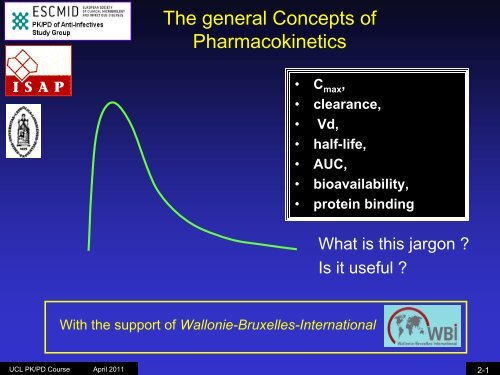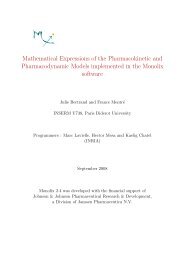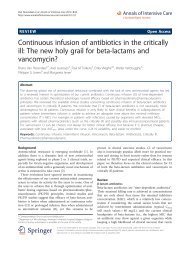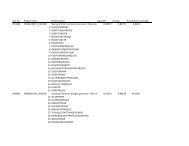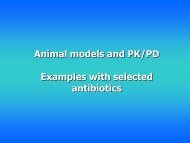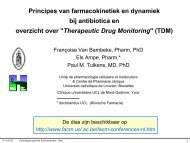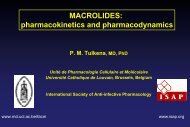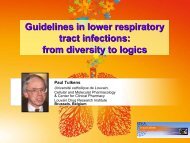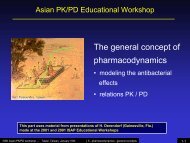2-Pharmacokinetics - UCL
2-Pharmacokinetics - UCL
2-Pharmacokinetics - UCL
Create successful ePaper yourself
Turn your PDF publications into a flip-book with our unique Google optimized e-Paper software.
The general Concepts of<br />
<strong>Pharmacokinetics</strong><br />
• C max ,<br />
• clearance,<br />
• Vd,<br />
• half-life,<br />
• AUC,<br />
• bioavailability,<br />
• protein binding<br />
What is this jargon ?<br />
Is it useful ?<br />
With the support of Wallonie-Bruxelles-International<br />
<strong>UCL</strong> PK/PD Course April 2011<br />
2-1
<strong>Pharmacokinetics</strong> is speed !<br />
<strong>UCL</strong> PK/PD Course April 2011<br />
2-2
The general Concepts of <strong>Pharmacokinetics</strong> (PK)<br />
C max<br />
AUC<br />
half-life<br />
• C max ,<br />
• clearance,<br />
• Vd,<br />
• half-life,<br />
• AUC,<br />
• bioavailability,<br />
• protein binding<br />
<strong>UCL</strong> PK/PD Course April 2011<br />
2-3
What is pharmacokinetics ?<br />
• " what the body does to the drug "<br />
• the fate of the drug in terms of<br />
– Absorption<br />
– Distribution<br />
– Metabolism<br />
– Excretion<br />
• the time course of drug and metabolite concentrations in the<br />
body<br />
<strong>UCL</strong> PK/PD Course April 2011<br />
2-4
What is pharmacokinetics ?<br />
• " what the body does to the drug "<br />
• the fate of the drug in terms of<br />
<strong>Pharmacokinetics</strong><br />
0.4= conc. vs time<br />
– Absorption<br />
– Distribution<br />
– Metabolism<br />
– Excretion<br />
Conc.<br />
0.0<br />
0 25<br />
Time<br />
• the time course of drug and metabolite concentrations in the<br />
body<br />
<strong>UCL</strong> PK/PD Course April 2011<br />
2-5
What is PK for ?<br />
PK is the way to see if the drug can be<br />
made useful …<br />
• does it reach the<br />
target in sufficient<br />
amounts ?<br />
• for long enough ?<br />
<strong>Pharmacokinetics</strong><br />
0.4= conc. vs time<br />
• does it each non-desired targets ?<br />
Conc.<br />
0.0<br />
0 25<br />
Time<br />
<strong>UCL</strong> PK/PD Course April 2011<br />
2-6
The C max is the highest concentration in plasma<br />
after administration ...<br />
concentration<br />
dose = 1<br />
C max<br />
time<br />
<strong>UCL</strong> PK/PD Course April 2011<br />
2-7
C max ... is proportional to the dose ...<br />
concentration<br />
dose = 1<br />
dose = 2<br />
C max<br />
C max<br />
time<br />
<strong>UCL</strong> PK/PD Course April 2011<br />
2-8
What is the significance of the C max ?<br />
• A drug with a (too) low C max may be ineffective<br />
if its activity is concentration-dependent<br />
• A drug with a (too) high C max may become<br />
toxic if toxicity is related to Cmax (this NOT<br />
always the case.... !)<br />
• you have to adjust the dose to get the<br />
appropriate C max !<br />
<strong>UCL</strong> PK/PD Course April 2011<br />
2-9
Clearance (Cl)<br />
in<br />
C i<br />
C o<br />
Q<br />
Eliminating<br />
Organ<br />
Quantity eliminated<br />
per unit of time<br />
out<br />
C o < C i<br />
the rate at which the drug will be excreted is<br />
proportional to<br />
• the blood flow in the eliminating organ (Q)<br />
• the extraction the organ is capable of (E)<br />
the clearance is thus Q x E (= L/h or ml/min)<br />
<strong>UCL</strong> PK/PD Course April 2011<br />
2-10
What is the significance of the clearance ?<br />
• A drug with a fast clearance will not stay<br />
around for long … and may require<br />
readminstration...<br />
• But a drug may show a slow clearance<br />
because it is bound to proteins and therefore<br />
largely unavailable (see later …)<br />
• If clearance falls during treatment (or is<br />
abnormally low at the beginning of treatment),<br />
patient will be overdosed !!<br />
<strong>UCL</strong> PK/PD Course April 2011<br />
2-11
Volume of distribution (V d )<br />
• Quantifies how the drug has access to<br />
the various compartments of the body<br />
• relates drug concentration (C) in the<br />
blood to the amount of drug that has<br />
been introduced in the body (= Dose)<br />
V d = Dose / Concentration in blood<br />
<strong>UCL</strong> PK/PD Course April 2011<br />
2-12
What is V d ?<br />
Think about the body as a large "bag" with compartments<br />
in which you drop a drug ...<br />
D<br />
plasma<br />
tissue<br />
<strong>UCL</strong> PK/PD Course April 2011<br />
2-13
What is V d ?<br />
If drug diffuses throughout the body ...<br />
Vd = 1 L/kg<br />
C max = dose /weight<br />
D<br />
D<br />
D<br />
serum concentration = tissue concentration<br />
<strong>UCL</strong> PK/PD Course April 2011<br />
2-14
What is V d ?<br />
If the drug reaches only the plasma<br />
and the extracelular fluids ...<br />
Vd < 1 L/kg<br />
C max > dose /weight<br />
D<br />
D<br />
high serum<br />
concentration<br />
no or little tissue<br />
concentration<br />
<strong>UCL</strong> PK/PD Course April 2011<br />
2-15
What is V d ?<br />
If drug accumulates in tissues...<br />
Vd > 1 L/kg<br />
C max < dose /weight<br />
D<br />
D<br />
low serum<br />
concentration<br />
high tissue<br />
concentration<br />
<strong>UCL</strong> PK/PD Course April 2011<br />
2-16
Typical volumes of distribution of antibiotics<br />
L/kg<br />
• dicloxacillin 0.1<br />
(serum only)<br />
• gentamicin 0.25<br />
(serum plus extracell. fluids)<br />
• ciprofloxacin 1.8<br />
(fluids plus moder. accumul. in tissues)<br />
• azithromycin 31<br />
(marked accum. in tissues)<br />
<strong>UCL</strong> PK/PD Course April 2011<br />
2-17
What is the clinical significance of the Vd ?<br />
• A drug with a small V d will have high initial<br />
blood levels but will not reach tissues...<br />
• A large V d will cause low initial blood levels …<br />
– if patient-related, you will need to give more<br />
of the drug (e.g., burn patients)<br />
– if drug-related, it may become ineffective in<br />
blood-related (invasive) infections<br />
<strong>UCL</strong> PK/PD Course April 2011<br />
2-18
Half-life (t 1/2 )<br />
• Half-life is the time it takes for the concentration to<br />
fall to half of its previous value<br />
• This is a parameter which is easy to measure,<br />
(just take a few blood samples…)<br />
BUT ...<br />
• it is secondary pharmacokinetic parameter<br />
because it depends on both the clearance AND<br />
the volume of distribution<br />
<strong>UCL</strong> PK/PD Course April 2011<br />
2-19
Why is half half-life a secondary parameter ?<br />
You start from here,<br />
but …<br />
this is C max ,<br />
i.e. Dose / Vd<br />
And you follow a slope<br />
which is dictated by the<br />
drug elimination rate,<br />
i.e the total body<br />
clearance<br />
<strong>UCL</strong> PK/PD Course April 2011<br />
2-20
Why is half half-life a secondary parameter ?<br />
t<br />
1/ 2<br />
0. 693<br />
CL<br />
Vd<br />
<strong>UCL</strong> PK/PD Course April 2011<br />
2-21
What is useful in half-life for the clinician ?<br />
• Direct information as how serum concentrations will<br />
fall over time …and reach a pre-set threshold ... if you<br />
know the C max (i.e. your starting point)<br />
• Direct, practical comparisons between drugs … if<br />
sharing the same V d ...<br />
You can compare -lactams between themselves<br />
for half-life, ...<br />
BUT you CANNOT compare -lactams (low<br />
Vd) and azithromycin (high Vd), e.g.<br />
<strong>UCL</strong> PK/PD Course April 2011<br />
2-22
Area under the Curve (AUC)<br />
Peak<br />
area under the curve<br />
trough<br />
AUC = dose / clearance<br />
<strong>UCL</strong> PK/PD Course April 2011<br />
2-23
• combines<br />
Area under the Curve (AUC)<br />
– one parameter directly linked to the medical<br />
decision: the dose of the drug !<br />
– one parameter llinked to the drug AND the<br />
patient: the clearance ...<br />
• its value is independent of the scheme of<br />
administration ...<br />
• useful to assess the total drug exposure<br />
<strong>UCL</strong> PK/PD Course April 2011<br />
2-24
24h-AUC / MIC of fluoroquinolones (p.o.)<br />
Drug Dosage 24h-AUC<br />
(mg/24h) (mg/L x h)<br />
norfloxacin 800 14 * , #<br />
ciprofloxacin 500 12 *<br />
ofloxacin 400 31 to 66 * , +<br />
levofloxacin 500 47 *<br />
moxifloxacin 400 48 *<br />
poor if MIC is <br />
Much better !!<br />
* US prescrib. inf. (adult of 60 kg) of NOROXIN®, CIPRO®, FLOXIN®, LEVAQUIN®, and<br />
AVELOX®<br />
#<br />
litterature data<br />
+<br />
first dose to equilibrium<br />
<strong>UCL</strong> PK/PD Course April 2011<br />
2-25
Bioavailability<br />
• quantifies ABSORPTION from the site fo<br />
administration to the blood<br />
• is measured by comparing oral (or another mode of<br />
administration) to intravenous administration<br />
A poor bioavailability reduces both C max<br />
and AUC ... and thereby decreases the<br />
potential for efficacy !!!<br />
<strong>UCL</strong> PK/PD Course April 2011<br />
2-26
A low bioavailability (F)reduces<br />
both C max and AUC<br />
F = 1<br />
C max<br />
concentration<br />
C max<br />
F = 0.5<br />
time<br />
<strong>UCL</strong> PK/PD Course April 2011<br />
2-27
Fluoroquinolones : bioavailability (p.o.) and C max<br />
Drug Dosage Bioav. C max<br />
(mg/24h) (%) (mg/L)<br />
norfloxacin 800 ~ 35 2.4 *<br />
ciprofloxacin 500 ~ 70 2.4 *<br />
ofloxacin 400 ~ 95 3-4.5 * , +<br />
levofloxacin 500 ~ 99 5-6 * , +<br />
moxifloxacin 400 ~ 90 4.5 *<br />
* US prescrib. inf. (adult of 60 kg) of NOROXIN®, CIPRO®, FLOXIN®,<br />
LEVAQUIN®, and AVELOX®<br />
+<br />
first dose to equilibrium<br />
<strong>UCL</strong> PK/PD Course April 2011<br />
2-28
Protein binding: it is (almost always)<br />
the free drug that acts ...<br />
vascular space<br />
extravascular space<br />
plasma<br />
protein<br />
binding<br />
binding to<br />
extracellular<br />
biological<br />
material<br />
blood cell<br />
binding,<br />
diffusion<br />
into blood<br />
cells,<br />
binding to<br />
intracellular<br />
biological<br />
material<br />
tissue cell<br />
binding,<br />
diffusion<br />
into tissue<br />
cells,<br />
binding to<br />
intracellular<br />
biological<br />
material<br />
<strong>UCL</strong> PK/PD Course April 2011<br />
2-29
Protein binding impairs and slows down drug<br />
distribution...<br />
TOTAL drug concentration of ertapenem (a high protein binding<br />
-lactam) in plasma and blister fluid after 3 days of treatement<br />
concentration<br />
(mg/L)<br />
150<br />
125<br />
100<br />
75<br />
50<br />
25<br />
0<br />
25<br />
plasma<br />
blister<br />
0 4 8 12 16 20 24<br />
time (h)<br />
7<br />
<strong>UCL</strong> PK/PD Course April 2011<br />
2-30
But protein binding prolongs half-lilfe ...<br />
100.0<br />
Ertapenem 1 g<br />
100.0<br />
Ceftriaxone 1 g<br />
concentration (mg/l)<br />
10.0<br />
1.0<br />
0.1<br />
0.01<br />
0 4 8 12 16 20 24<br />
ceftriaxone data:<br />
total<br />
free<br />
10.0<br />
1.0<br />
0.1<br />
0.01<br />
0 4 8 12 16 20 24<br />
time (h)<br />
total<br />
free<br />
Paradis et al, AAC 1992, 36: 2085-2092<br />
Perry & Schentag, Clin Pharmacokinet. 2001, 40: 685-694<br />
<strong>UCL</strong> PK/PD Course April 2011<br />
2-31
<strong>Pharmacokinetics</strong><br />
This where we are ...<br />
Concentration at<br />
site of infection<br />
Got it ?<br />
Dosing<br />
Concentration in<br />
blood<br />
Concentration<br />
in non-target<br />
tissues<br />
Section 3A<br />
<strong>UCL</strong> PK/PD Course April 2011<br />
2-32


